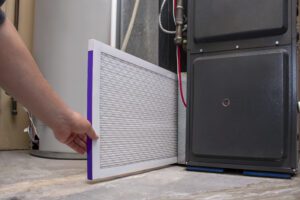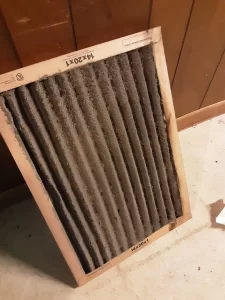Need to Change the Furnace Filter More Frequently?
There are certain circumstances that can lead homeowners to replace their filters more frequently.
Pets
If you have furry friends sharing your home, their shedding can significantly impact your furnace filter’s lifespan. Pet dander, fur, and other allergens tend to circulate in the air and get trapped in the filter, reducing its efficiency. It is recommended for pet owners to check their filters every 1-2 months and replace them as needed to maintain clean air quality.
Allergens and Pollen
If you live in an area with high pollen counts or have allergy sufferers in your household, you may need to change your furnace filter more frequently. Pollen, mold spores, and other outdoor allergens can find their way into your home and accumulate in the filter, affecting air quality. Consider using a higher-rated filter, such as a pleated or high-efficiency filter, and check it every 1-2 months during peak allergy seasons.
Dust and Construction
Home renovations or construction projects can introduce significant amounts of dust and debris into the air. Even if you’re not undergoing construction, daily household activities like vacuuming, sweeping, or moving furniture can stir up dust particles. These airborne particles can clog your furnace filter faster, requiring more frequent replacements. During such activities, check your filter monthly and be prepared to change it more often.
READ MORE: Duct Cleaning After Remodeling
 The Process of Changing Your Furnace Filter:
The Process of Changing Your Furnace Filter:
Now that we’ve covered the different types of filters and their replacement intervals, let’s go over the step-by-step process of changing your furnace filter:
Preparation: Start by turning off your furnace. This will prevent any airflow during the filter replacement process. Locate the filter compartment, which is usually near the blower motor or the return air duct.
Filter Removal: Carefully remove the existing filter from its housing. Note the direction of airflow indicated on the filter frame. This is important to ensure proper installation of the new filter.
Inspection: Take a moment to inspect the old filter. If it appears dirty or clogged with debris, it’s a clear sign that it needs to be replaced. A clean filter will have a white or off-white appearance.
Choosing the Right Filter: Refer to your furnace’s user manual or consult with an HVAC professional to determine the correct filter size and type for your specific system. Ensure the new filter matches the dimensions of the old one.
Installation: Insert the new filter into the filter housing, making sure the airflow direction matches the arrow or indicator on the filter. Double-check that the filter is snugly fit and properly aligned.
Restart the Furnace: Once the new filter is securely in place, turn the furnace back on. Allow the system to run for a few minutes and ensure proper airflow. If everything looks and feels normal, you’ve successfully changed your furnace filter!
What Happens if my Filter Gets Clogged? 
When a furnace filter becomes clogged, it can have several negative effects on both your HVAC system and the indoor air quality of your home.
Reduced Airflow: A clogged filter restricts the flow of air through your HVAC system. As a result, less air can circulate, leading to decreased comfort levels in your home. Rooms may feel stuffy or unevenly heated/cooled, and it may take longer for your system to reach the desired temperature.
Decreased Energy Efficiency: When the airflow is impeded by a clogged filter, your HVAC system has to work harder to maintain the desired temperature. The increased strain on the system can cause it to consume more energy, leading to higher utility bills. Reduced efficiency also shortens the lifespan of the HVAC equipment.
Poor Indoor Air Quality: The primary function of a furnace filter is to trap airborne particles and contaminants, preventing them from circulating through your home. However, a clogged filter loses its effectiveness, allowing dust, allergens, pet dander, and other pollutants to bypass the filter and enter your living spaces. This can lead to worsened indoor air quality, triggering allergies, respiratory issues, and general discomfort for occupants.
HVAC System Malfunction: A severely clogged filter can strain your HVAC system to the point of malfunction. The restricted airflow can cause the furnace or air conditioner to overheat, potentially leading to system shutdown or damage. This can result in costly repairs or even the need for a complete system replacement.
Ice Formation: In cooling systems, a clogged filter can lead to reduced airflow and cause the evaporator coil to freeze. The ice formation inhibits the coil’s ability to cool the air effectively, resulting in inadequate cooling and potential damage to the system.
Need Help With Your Furnace Filter Change?
If you’re near Cincinnati, OH and need help figuring out how to change your furnace filter or are having other HVAC issues, don’t hesitate to reach otu to Quality Comfort Home Services at 513-620-4822 or schedule service online anytime.


 The Process of Changing Your Furnace Filter:
The Process of Changing Your Furnace Filter: